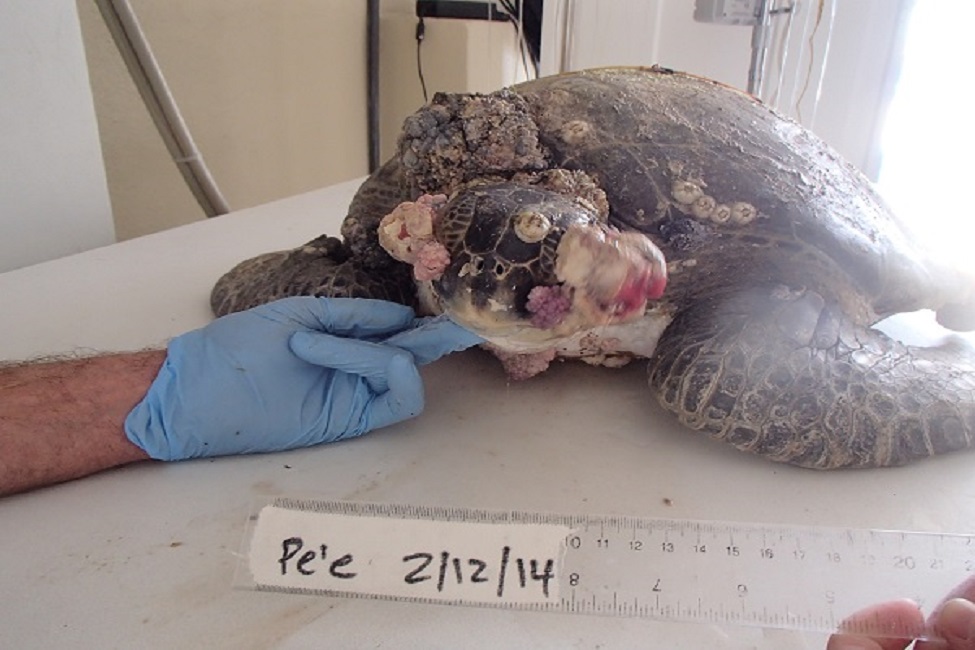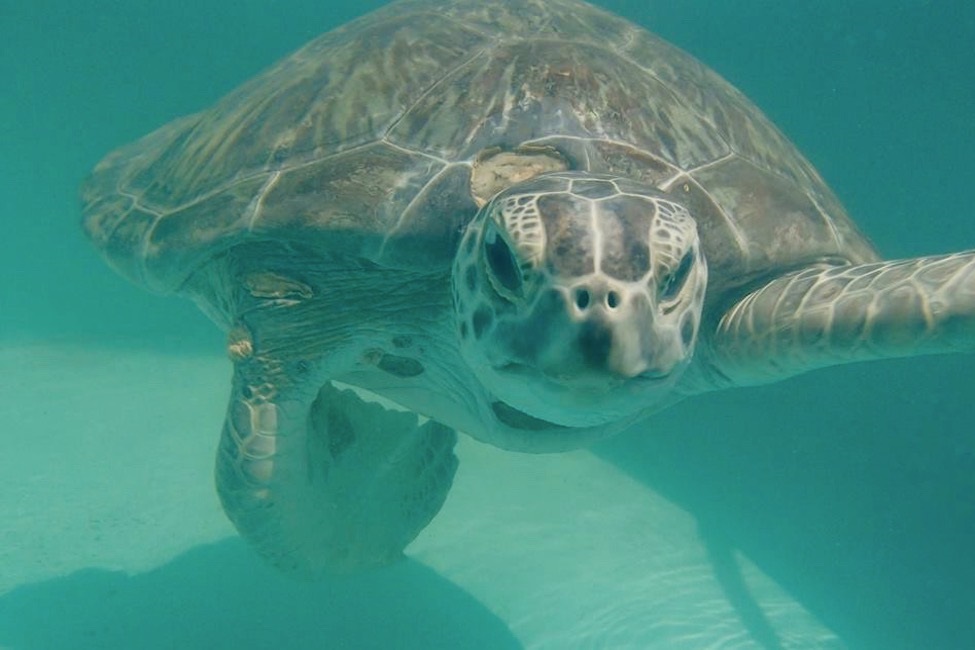Most Rehabilitating Sea Turtles with Infectious Tumors Don’t Survive

(Before) Pe'e, a green sea turtle with fibropapillomatosis was rehabilitated and successfully released by The Turtle Hospital. (Photo credit: The Turtle Hospital)
Caused by a herpesvirus, fibropapillomatosis (FP) is the most significant infectious disease affecting sea turtle populations worldwide. It is widespread in warmer climates like Florida, where almost 70 percent of sea turtles in a population have FP in some places; it has been documented in the Caribbean, South America, Hawaii, Japan, Australia, and beyond. The disease leads to the formation of tumors on the turtles’ eyes, flippers and internal organs, which often debilitate them by inhibiting feeding and movement, obscuring vision, and/or leading to organ failure.
FP is of major concern in sea turtle rehabilitation facilities and requires extensive quarantine measures to accommodate infected turtles. Even after surgical removal, there is still potential for tumor regrowth since the underlying associated herpesvirus infection remains dormant. These clinical factors, along with the infectious and potentially life-threatening nature of FP, complicate prognoses and extend rehabilitation times of sea turtles diagnosed with this disease.
Annie Page-Karjian, D.V.M., Ph.D., a researcher from Florida Atlantic University’s Harbor Branch Oceanographic Institute and collaborators, conducted a large-scale, retrospective case series review evaluating tumor score, removal and regrowth in rehabilitating green sea turtles with FP in four rehabilitation facilities in the southeastern United States from 2009 to 2017. The objective was to assess FP tumor score and regrowth and provide information on tumor regrowth and survival in turtles with different tumor scores. Applying a standardized method for quantifying and qualifying the extent of the disease is necessary to objectively understand the various clinical manifestations of the disease.
Results of the study, published in the journal Diseases of Aquatic Organisms , showed that the majority (75 percent) of the turtles with FP did not survive following admission into a rehabilitation facility, irrespective of whether or not tumor regrowth occurred following surgery. FP is of greatest concern in juvenile sea turtles in nearshore habitats. All of the green turtles with FP in this study were classified as juveniles.
Of the 756 cases, 312 (41 percent) underwent tumor removal surgery, 155 (50 percent) of those had tumor regrowth within an average of 46 days, and 85 (27 percent) had multiple (more than one) regrowth events. Of the 756 turtles with FP, 283 (37 percent) were euthanized and 280 (37 percent) died without euthanasia. Of the 756 turtles with FP, 193 survived, including 186 (25 percent) that were released and seven (1 percent) that were placed in permanent captive care.
“Evaluating cases of rehabilitating wildlife can be an extremely valuable approach for improving our understanding of pathogen activity in both captive and free-ranging wildlife, and for developing recommendations for treatment and management of important wildlife diseases,” said Page-Karjian, senior author, an assistant research professor and clinical veterinarian at FAU’s Harbor Branch. “Results from our study could help guide clinical decision-making and determine prognoses for rehabilitating sea turtles with fibropapillomatosis.”
Tumor removal surgery increased the odds of tumor regrowth, but also enhanced survivorship, whereas tumor regrowth was not a significant predictor of case outcome. Three FP tumor-scoring systems were used to assign tumor scores to 449 cases, and differing results emphasize that tumor-scoring systems should be applied to the situations and/or location(s) for which they were intended. FP tumor score was not a significant predictor for the event or extent of FP tumor regrowth after surgical excision.
“Internal tumors or severe fibropapillomatosis irreversibly diminishes an animal’s well-being and ability to survive,” said Page-Karjian. “Application of the appropriate scoring system coupled with rigorous triage and admission criteria for stranded turtles with this disease can effectively help reduce facilities’ burden in terms of rehabilitating fewer turtles with poor prognoses.”
In situations of limited resources, and taking into account any co-morbid conditions, focusing rehabilitation efforts on turtles with lower tumor scores (i.e. one to two) will help further streamline admission and triage of turtles with FP in rehabilitation facilities, and lead to higher rehabilitation success rates.
Study collaborators represent Loggerhead Marinelife Center in Juno Beach; The Turtle Hospital, in Marathon; Clearwater Marine Aquarium in Clearwater; the Sea Turtle Healing Center at Brevard Zoo in Melbourne; and Georgia Sea Turtle Center/Jekyll Island Authority, in Jekyll Island, Georgia.
This project was funded in part by a grant awarded from the Sea Turtle Grants Program, which is funded from proceeds from the sale of the Florida Sea Turtle License Plate.

-FAU-
Tags: research | faculty and staff | science | harbor branch